FIRST SHOWN in the American Bicentennial year of 1976, The Milpitas Monster movie was conceived as a commercial art class project in 1972 at Samuel Ayer High School. (See photo below.)
Milpitas Cultural Timeline:
1954–present (City of Milpitas)
1972–76—Making The Milpitas Monster Movie
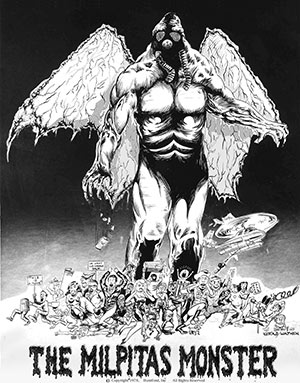 The iconic Milpitas Monster poster was designed by David Kottas and Stephen Wathen (Stephen also did the animation sequences in the film).
The iconic Milpitas Monster poster was designed by David Kottas and Stephen Wathen (Stephen also did the animation sequences in the film).Written by Joseph Ehardt, September 2018, and subsequently published in altered form in The Milpitas Beat, Volume 1, Issue 6 (October 2019).
The Monster Was Born
The initial plan in January 1973 simply was to make a ten-minute short film about pollution. Robert Burrill was the instructor guiding and implementing the project. Art student David Kottas created the monster’s image, inspired by classic horror movies such as Godzilla, King Kong, and The Creature from the Black Lagoon. Another student, Patty Thorpe, got the job of designing and sewing the costume for the monster, and she was helped by her mother Anna, a professional tailor. From David Kottas’ drawings, Patty made the head and wings, and thus “the Monster was Born!” Scott Parker, the largest student in the Film Production class, was chosen to be the actor inside the costume.
The Milpitas Monster Booster Fan Club Was Formed
Production cost for the 16 mm film was met by asking local merchants near the school for small donations with the promise that their names would be acknowledged in the film’s credits. With one of the “truly great film titles,” Burrill collected $200 in 15 minutes, which was enough to pay for black-and-white film stock and its processing. He soon realized, however, that a thirty-minute color film could be made for only a few dollars more; a week later Burrill had collected an additional $1,000. Robert recounts,
“I knew I had something at that point and I asked my Adult Education Photography class for their help and ideas. A task force was formed and the Milpitas Monster Booster Fan Club was established.” Robert Burrill
Soon images of the Milpitas Monster were on the front page of the Milpitas Post and the San Jose Mercury News, with headlines of “A Star is Born in Milpitas” and “The Milpitas Monster makes his movie debut.”
Local filmmakers and theatre groups were consulted for additional ideas. Burrill notes that “the concept of a fifty-foot monster stealing garbage cans brought immediate laughter. Brainstorming with people trained to think theatrically produced many ideas to choose from, and thus a series of drafts of the script were produced for a potential thirty-minute film.”
Monster Destroys Kozy Kitchen Restaurant!
Wanting something dramatic, the team decided that the Milpitas Monster would destroy the Kozy Kitchen restaurant, a Milpitas landmark, but the miniature model of it for filming had to be believable. The first model was not very realistic, so it was set aside and Duane Walz (a father of three Ayer HS students, a retired technical engineer, and an experienced model maker) supervised five Ayer student assistants in building a much more accurate miniature.
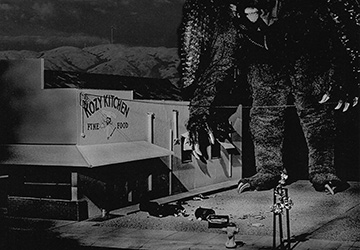 The Milpitas Monster, a.k.a. Noitullop or (in case we missed it) Pollution spelled backward, is “rehearsing” the scene of a raid of the Kozy Kitchen (scale model) for a garbage snack.
The Milpitas Monster, a.k.a. Noitullop or (in case we missed it) Pollution spelled backward, is “rehearsing” the scene of a raid of the Kozy Kitchen (scale model) for a garbage snack. Burrill contacted an old school buddy, David Boston, who was writing for the Hollywood scene. Over the Christmas holidays a professional draft script was completed by Boston. Concentrated shooting began during summer school, with schedules compiled each morning and actual filming occurring every other day for a two-month period.
One stage actor, Doug Hagdohl, wanted film experience, so he was offered a role in the movie, and then the Milpitas police and fire departments enthusiastically joined the project. Burrill notes that
“the fire department stations almost got into an argument as to which fire house would be used the most!” Bob Burrill
In cult classic horror films of that era, narrators were commonly used to connect the film segments for the viewers. The well-known Tennessee Ernie Ford was approached and initially agreed to narrate the film, but he later backed out of that commitment. His replacement was Paul Frees, another famous actor, who had the perfect narrator’s voice.
Additional help for this student project came from many sources. Stephen C. Wathen, a local graphic artist, theatrical designer and filmmaker, added sequences of stop-motion animation to make the monster fly. Robert Berry, a professional musician and composer, agreed to compose special music – “The Milpitas Monster” and “Dining in the City Dump” – for the growing feature film. George Loughborough, owner of Huntford Graphics and Printing in Milpitas, produced professional advertising.
A short clip of the Kozy Kitchen scene was sent to Bob Wilkins, the 1970s cigar-smoking host of the Creature Features show on KTVU, who had been making televised fun of Milpitas and the project as word spread in South Bay newspapers. After watching the clip, Wilkins became a fan of the project and several TV appearances of Robert Burrill on the show happened.
 Filmmaker Robert Burrill with Bob Wilkins, 1970s TV host of
Creature Features on KTVU.
Filmmaker Robert Burrill with Bob Wilkins, 1970s TV host of
Creature Features on KTVU. Ten-Minute Short Grows Into Ninety-Minute Feature Film
The original ten-minute short film project was growing magically into a ninety-minute feature movie…
As the project progressed, the whole town awaited any scrap of news about the film’s completion. Publicity dropped off completely as Burrill labored for weeks in a home-made studio during the editing of the film. Finally, a time was set late in the school year for the movie’s world premiere.
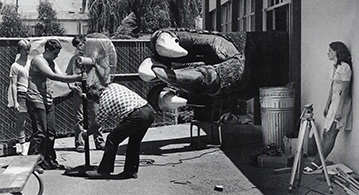 Actress Priscilla House, daughter of Mayor Joseph House (both of whom
were in the movie) is waiting while the film crew sets up equipment for a
“take” of a scene reminiscent of King Kong grabbing the heroine.
Actress Priscilla House, daughter of Mayor Joseph House (both of whom
were in the movie) is waiting while the film crew sets up equipment for a
“take” of a scene reminiscent of King Kong grabbing the heroine. Priscilla in the Milpitas Monster’s Grip
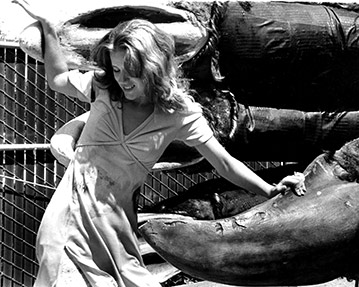 Finally, the “take.”
Finally, the “take.”Milpitas Civil Defense Team Prepares to Take on Monster
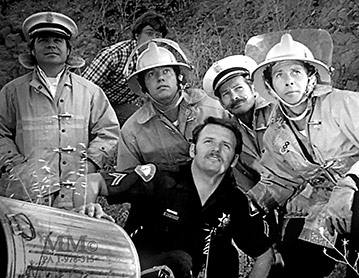 The Milpitas Civil Defense team getting ready to destroy the Milpitas Monster.
The Milpitas Civil Defense team getting ready to destroy the Milpitas Monster.1976—Bicentennial Commission Endorses Milpitas Monster Movie & World Premier at Serra Theater
The Milpitas Monster movie was endorsed by the 1976 Bicentennial Commission as a night of celebration. Searchlights and a red carpet were ordered and publicity once again appeared in the newspapers. To Burrill’s joy, 500 World Premiere tickets were sold out in two weeks for $5.00 apiece.
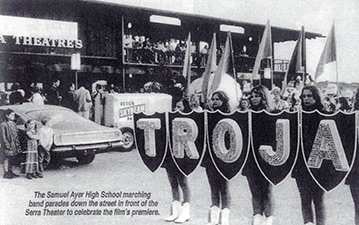 The 1976 World Premier of the Milpitas Monster movie at Serra Theater.
The 1976 World Premier of the Milpitas Monster movie at Serra Theater.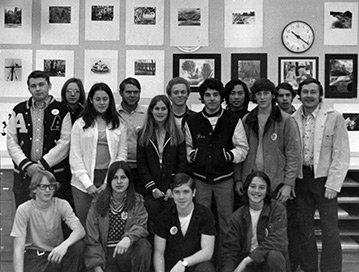 Special Credits: The Samuel Ayer High School makers of the Milpitas Monster film, a grouping in 1975.
Special Credits: The Samuel Ayer High School makers of the Milpitas Monster film, a grouping in 1975.